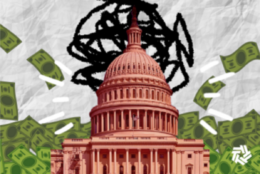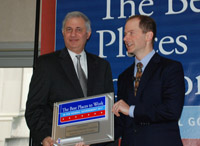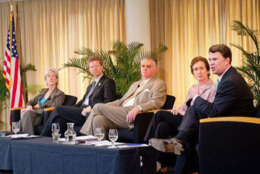Max Stier
-
More and better information is getting to be the driving force behind spending and program decisions across the government. OMB is requiring agencies to update strategic plans and objectives based on their analysis of program and back-office data.
November 21, 2013 -
On the In Depth show blog, you can listen to our interviews, find more information about the guests on the show each day, as well as links to other stories and resources we discuss.
August 14, 2013 -
A new report by the Partnership of Public Service and Booz Allen Hamilton calls for a multiagency enterprise approach to the way the federal government handles major public policy goals.
August 08, 2013 -
Sequestration? Furloughs? Pay freeze? Fed bashing? Poor leadership? The list of morale killers goes on and on. A new Federal News Radio survey on employee morale and leadership -- part of our special report, Leaders in Federal Service -- shows just how bad people are feeling in the federal workforce.
February 28, 2013 -
Times of tight budgets, impending sequestration and a possible government shutdown require good leaders who can make tough decisions. But who are those leaders? Federal News Radio asked our readers to nominate people they work with who demonstrate the qualities of good leadership. You responded, we listened and a panel of judges picked the five Top Leaders in Federal Service.
February 27, 2013 -
NASA, the Surface Transportation Board and the Federal Deposit Insurance Corporation share a common trait that led them to the top ranking for their size class in the Partnership for Public Service's seventh annual Best Places to Work survey. Transportation, OMB and the National Credit Union Administration earn the most improved status by implementing the best practices of the leading agencies.
December 14, 2012 -
Pamela Wright talks about innovation and paper records at NARA. Max Stier of the Partnership for Public Service elaborates about the best federal agencies to work based on the nonprofit group's survey. A retired federal couple, one is on FERS and the other on CSRS, tell how they make it work.
December 13, 2012 -
The Partnership for Public Service and Deloitte released the 2012 Best Places to Work in Federal Government rankings today. While some agencies improved their employee satisfaction rankings, the majority did not, resulting in the greatest overall change -- a 3.2 point drop -- since the rankings began.
December 13, 2012 -
The next five to 10 years may represent a once-in-a-generation period of challenges and opportunities for the Federal government. The question isn't whether or not your organization will be affected by the shifts but whether or not your organization will be out in front of them. Reduced budgets combined with unchanged - or more complex - missions have resulted in increasing workloads, which have sent agencies searching for ways to leverage limited resources while striving to improve mission performance. So, how can agencies reduce inefficiencies and redundancies without significantly impacting their core missions?
July 23, 2012 -
Some departments are improving personnel practices around recruitment and knowledge management even in the face of pay freezes and criticisms of public servants. DHS created a higher education engagement group to bring in college students. GSA finds quality of applicants still strong. Senior leaders highlight successes during Public Service Recognition Week.
May 09, 2012 -
Top ranked agencies say constant contact with employees is key to success. FDIC moved from the bottom in 2005 to the top this year. Surface Transportation Board takes top spot among small agencies for second year in a row.
November 17, 2011 -
Federal hiring still takes too long and asks too much of applicants. But the agency hiring process is inching closer to mirroring the private sector. Officials, academics, analysts and union representatives agreed that agencies need to take the next steps to maintain progress.
September 29, 2011 -
The morale of workers is on the rise after recent events highlighted the work the government does, officials say. Agencies also are taking specific steps to address employee challenges in their own agencies. DoT Secretary Ray LaHood said \"pot shots\" at employees is unacceptable.
May 04, 2011 -
The Senior Executives Association and the Partnership for Public Service testified before a subcommittee with improvement to SES and ways Congress can help.
March 30, 2011 -
The Partnership for Public Service\'s Max Stier argues for a restructuring of the General Schedule, a key issue in the debate over federal employee pay.
March 16, 2011





